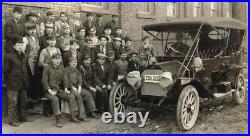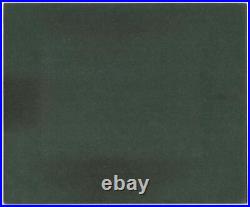S15, 528-09, 1911, Cabinet Card, Marion Motor Co, Manufacturing Bldg & Employees




S15, 528-09, 1911, Cabinet Card, Marion Motor Co, Manufacturing Bldg & Employees. On the back is written "Feb 27, 1911". More Info on Marion Motor Co. The Marion was an automobile produced by the Marion Motor Car Company in Indianapolis (Marion County), Indiana from 1904 to 1915. Marion was also used for prototype automobiles in 1901 by the Marion Automobile Company of Marion, Ohio, which later operated as a garage.
A Marion Flyer was listed in 1910 by the Marion Automobile & Manufacturing Company in Marion, Indiana, but no production was reported. In 1904 the Marion Motor Car Company, based in Indianapolis, entered automobile production building mid-priced to high-priced automobiles. Early versions of the Marion car had transversely-mounted 16-hp Reeves air-cooled engines, and double chain drive. The appearance of the Marion car was very similar to the contemporary Premier (also an Indianapolis car). 1906 Marion cars had conventionally-placed 16 and 28-hp 4-cylinder Reeves engines, while later Marion cars used water-cooled engines by Continental and other firms of up to 48-hp.
Automotive engineers and designers, Robert Hassler, Fred Tone, George Schebler and Harry C. Stutz produced or designed models for Marion. Motor car racing was actively undertaken to provide recognition for Marion. Beginning in 1907 Harry Stutz was chief engineer for Marion. He designed a roadster named the Bobcat Speedster, which bore a close resemblance to the contemporaneous Stutz Bearcat Speedster. Willys, President of Overland Automobile Company, bought controlling interest in Marion in October, 1908. Handley, president of American Motor Car Company became President of Marion Motor Car Company and combined their sales organizations. Automobile, The Marion Car, New Car, Vehicle, People, Men, Fashion, Hats, Cigar, Pipe.Card size: 12" x 10". Was a style of photograph which was widely used for photographic portraiture after 1870.
It consisted of a thin photograph mounted on a card typically measuring 108 by 165 mm (4+1? The carte de visite was displaced by the larger cabinet card in the 1880s. In the early 1860s, both types of photographs were essentially the same in process and design.Both were most often albumen prints, the primary difference being the cabinet card was larger and usually included extensive logos and information on the reverse side of the card to advertise the photographer's services. However, later into its popularity, other types of papers began to replace the albumen process. Despite the similarity, the cabinet card format was initially used for landscape views before it was adopted for portraiture.
Some cabinet card images from the 1890s have the appearance of a black-and-white photograph in contrast to the distinctive sepia toning notable in the albumen print process. These photographs have a neutral image tone and were most likely produced on a matte collodion, gelatin or gelatin bromide paper. Sometimes images from this period can be identified by a greenish cast. Gelatin papers were introduced in the 1870s and started gaining acceptance in the 1880s and 1890s as the gelatin bromide papers became popular. Matte collodion was used in the same period. A true black-and-white image on a cabinet card is likely to have been produced in the 1890s or after 1900. The last cabinet cards were produced in the 1920s, even as late as 1924.Owing to the larger image size, the cabinet card steadily increased in popularity during the second half of the 1860s and into the 1870s, replacing the carte de visite as the most popular form of portraiture. The cabinet card was large enough to be easily viewed from across the room when typically displayed on a cabinet, which is probably why they became known as such in the vernacular.
Whatever the name, the popular print format joined the photograph album as a fixture in the late 19th-century Victorian parlor. VG-VG/EX (edge & corner wear, writing on the back).
Please see scans for actual condition. Would make a great addition to your collection or as a Gift (nice for Framing). Newest Collections with FREE S&H.
To see all my Postcards. To see all my Movie Items. To see all my Disney Items. To see all my Baseball Items. To see all my Boy Scout Cards.
To see all my Stereoview Cards. Add me to your Favorite Sellers and Sign up for my Newsletter. Ground Advantage (the old 1st class).Please look at my other Auctions for more Collectibles of the 1800's-1900's. Get Supersized Images & Free Image Hosting. Create your brand with Auctiva's. Attention Sellers - Get Templates Image Hosting, Scheduling at Auctiva.
